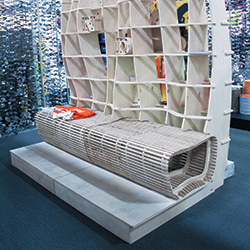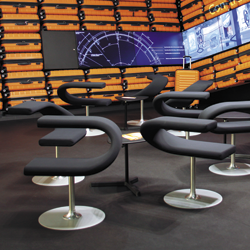PORTABLE/MODULAR EXHIBITS
 Instead of building a custom exhibit, I'd like to invest in a portable/modular system. However, my boss, who has been in the business for decades, has a very negative - and perhaps outdated - perception of them. Can you explain what has changed since they debuted that allows portable/modulars to be a viable, almost-custom solution today? Instead of building a custom exhibit, I'd like to invest in a portable/modular system. However, my boss, who has been in the business for decades, has a very negative - and perhaps outdated - perception of them. Can you explain what has changed since they debuted that allows portable/modulars to be a viable, almost-custom solution today?
 To understand how far portable/modulars have come - and to give you some ammunition to argue against your boss's concerns - you have to start with a little history. To understand how far portable/modulars have come - and to give you some ammunition to argue against your boss's concerns - you have to start with a little history.
Developed in the mid-70s, the first portable exhibit - a pop-up display - was basically an aluminum frame with cross bracing and a self-locking technology or geometry, meaning it didn't require fasteners or connectors to stay erect. The entire frame, which was available in a curved form, packed into a cylindrical case, along with flexible graphics panels. Shelves and incandescent lights were packed into separate cases.
To set it up, exhibitors simply popped open the frame and attached individual square panels that had grommets on four corners. The first pop-up display was available for use as a 10-foot-wide back wall.
So while early pop-ups offered easy transport and setup, they also had their drawbacks, as exhibitors were limited to using only square graphic panels and space sizes of 10-by-10 or less.
Nevertheless, this system remained popular until around the mid-90s when a Fiberglas version was introduced. It had some cross bracing, but also required front-to-back connectors to stay erect, meaning some assembly was required. It also had magnetic channel bars and fabric panels that rolled up instead of the individual square panels.
With this new system, hook-and-loop-compatible graphics, such as headers and signage, could be attached to the rollable fabric panels, and lights and shelves could also be incorporated. So while the Fiberglas system provided more flexibility and functionality, it was also more cumbersome than the original pop-up and required two full-size shipping crates to transport.
When the first pop-up debuted in the mid-70s, the only other portable exhibit in existence was a folding panel system, which was much heavier than a pop-up display. It consisted of a frame that was hinged together, and rigid graphics panels were installed within the frame. This type of portable system was popular for the ability to change the shape or size of a display by rearranging various components. While exhibitors simply had to unfold the frame to install the booth, the heavier materials meant an increase in shipping and drayage costs.
During the '90s, pop-up models expanded from a 10-foot back wall to include tabletop, tower, 8-foot back wall and larger models. And fabrics became available in a wide range of colors, providing further customization. However, exhibitors were increasingly looking for portable/modular options that were functional yet offered even more options for customization.
Thus, portable/modulars became more flexible and reconfigurable with the development of flat-wall technology, which means that internal components, such as shelving with downlighting and
back-lit boxes, could be accommodated into portable/modular designs. Furthermore, case-to-counter conversion kits were introduced, which allowed exhibitors to convert the portable/modular wheeled cases into a counter. Portable counters with internal storage were also introduced, giving exhibitors additional customization options and increased functionality. Adding to the convenience, all of these materials could be housed in three rolling cases - two for the display components and counter conversion kit and a third for an optional portable counter with internal storage.
Thus, today's portable systems, which include myriad options - pop-ups, tabletop displays, literature stands, banner stands, counter systems, kiosks, etc. - offer more customization and alternatives than choice of fabric color.
Given the rapid evolution of portables - both in terms of customization options and overall appearance and ease of use - they're a wise choice for many exhibit programs. So to ease your boss's concerns, start by explaining some of this history and showing him or her photos of what's currently available. He or she will likely be surprised at how past perceptions have nothing to do with current realities.
However, if your boss is still hesitant about abandoning a custom property, consider a hybrid solution, in which you can incorporate portable and modular system components into your existing custom property. Hybrid solutions offer the sophistication of traditional custom-built exhibits but blend pop-ups, laminated panels, and aluminum extrusion with fabric or rollable graphics, lighting, and functional accessories.
Whether you decide to take the leap and go entirely portable/modular or you start with baby steps and incorporate portable/modular components into your existing custom property, portable/modulars usually offer the best of both worlds - a functional, flexible, and almost fully customizable exhibit property.
- Gwen Parsons, senior vice president, Nomadic Display, Springfield, VA
PROMOTIONAL POWER WORDS
 I have to write all of our exhibit-marketing copy, including text for our graphics. What are some "power words" that leap out and grab readers' attention? I have to write all of our exhibit-marketing copy, including text for our graphics. What are some "power words" that leap out and grab readers' attention?
 You're right. There are a handful of promotion-related words that seem to make readers stop and take notice. But as with just about everything else, less is more. Use the following words sparingly and strategically to increase the effectiveness of your marketing and graphics text. You're right. There are a handful of promotion-related words that seem to make readers stop and take notice. But as with just about everything else, less is more. Use the following words sparingly and strategically to increase the effectiveness of your marketing and graphics text.
 Safety/Safe - Safety is a basic human need, and identifying your product's safety benefits connotes a sense of reliability and trustworthiness. Plus, given today's liability risks, safety is a major concern for most business-to-business buyers, and anything with safety built in is probably a plus. Safety/Safe - Safety is a basic human need, and identifying your product's safety benefits connotes a sense of reliability and trustworthiness. Plus, given today's liability risks, safety is a major concern for most business-to-business buyers, and anything with safety built in is probably a plus.
 Results - We all want some kind of result. So point out how your product or service delivers "results" for your target audience, and if possible, supply actual metrics or testimonials to prove your claim. Results - We all want some kind of result. So point out how your product or service delivers "results" for your target audience, and if possible, supply actual metrics or testimonials to prove your claim.
 New - People come to trade shows to see what's new in their industry. So using the word "new" on your graphics or in your pre- or at-show promotions is a surefire way to catch people's attention. New - People come to trade shows to see what's new in their industry. So using the word "new" on your graphics or in your pre- or at-show promotions is a surefire way to catch people's attention.
 Save - Everybody loves a bargain, especially in today's tight economy. If you have a special limited-time price, refer-a-friend deal, or volume discount, highlight the benefit of your offer with the word "save" or "savings." Save - Everybody loves a bargain, especially in today's tight economy. If you have a special limited-time price, refer-a-friend deal, or volume discount, highlight the benefit of your offer with the word "save" or "savings."
 Proven - The word "proven" suggests that other customers have tried your product and its success has been proven time and time again. Thus, the word helps remove the fear of the unknown, and increase the likelihood of a purchase. Proven - The word "proven" suggests that other customers have tried your product and its success has been proven time and time again. Thus, the word helps remove the fear of the unknown, and increase the likelihood of a purchase.
Guarantee - If your product has a guarantee, state it. Similar to the word "proven," it takes some of the perceived risk out of purchasing.
 Free - Everybody loves a freebie, so this word is probably the most potent motivator in direct response. A pre-show e-mail stating that people can get a "free gift" in your booth may be enough to drive them to your space. Free - Everybody loves a freebie, so this word is probably the most potent motivator in direct response. A pre-show e-mail stating that people can get a "free gift" in your booth may be enough to drive them to your space.
Again, less is more. Strategically using one or two of these words per promotion is plenty.
- Karen Talavera, president and founder, Synchronicity Marketing, West Palm Beach, FL
|






 Instead of building a custom exhibit, I'd like to invest in a portable/modular system. However, my boss, who has been in the business for decades, has a very negative - and perhaps outdated - perception of them. Can you explain what has changed since they debuted that allows portable/modulars to be a viable, almost-custom solution today?
Instead of building a custom exhibit, I'd like to invest in a portable/modular system. However, my boss, who has been in the business for decades, has a very negative - and perhaps outdated - perception of them. Can you explain what has changed since they debuted that allows portable/modulars to be a viable, almost-custom solution today? To understand how far portable/modulars have come - and to give you some ammunition to argue against your boss's concerns - you have to start with a little history.
To understand how far portable/modulars have come - and to give you some ammunition to argue against your boss's concerns - you have to start with a little history.


